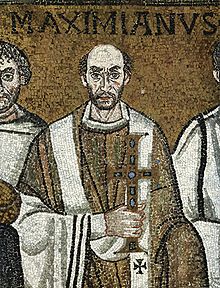Maximianus | |
|---|---|
 Detail of Maximian in San Vitale, Ravenna | |
| Archbishop of Ravenna | |
| Born | 499 Pula, Ostrogothic Kingdom |
| Died | 556 (aged 57) Ravenna, Exarchate of Ravenna |
| Venerated in | Roman Catholic Church Eastern Orthodox Church |
| Feast | February 21 (East) February 22 (West) |
Maximianus of Ravenna, or Maximian (499 – February 22, 556; feast day formerly February 21) was bishop of Ravenna in Italy. Ravenna was then the capital of the Byzantine Empire's territories in Italy, and Maximianus's role may have included secular political functions.